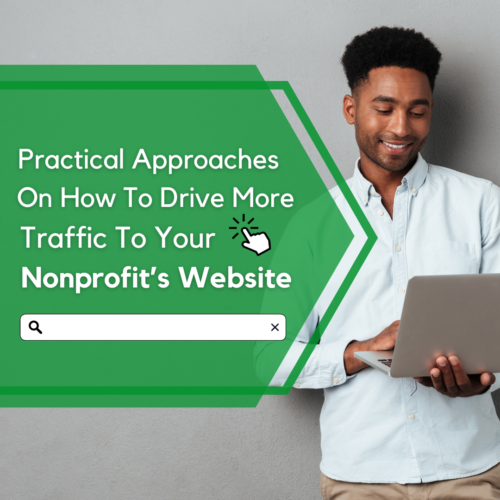Table of contents
Marketing strategies to boost your nonprofit’s website traffic

1. Identify your target audience and start an email newsletter
To identify your target audience follow these three steps:
- Identify your goals:
Each organization has its own set of goals, and it is important that know what yours are. By identifying your most important goals, you can easily prioritize and focus on the people that matter the most to your nonprofit right now.
2. Determine your target audience:
Determining your target audience will help you spend as much time and resources as possible on reaching the people that matter most to your nonprofit; you do not want to waste resources trying to target audiences that will not help you grow.
Time to do some research:
An excellent place to start would be with your current base of supporters. Pull up your community’s database and look for any patterns; “groups that are within a certain age bracket”, “groups that donate during a certain time of the year”, and “groups that have certain hobbies” are but a few examples of patterns that may crop up.
Once you have created groups, choose a few people from each group and schedule phone interviews with them. This will give you deeper insight into each group, and may even help you discover more groups that belong to your organization. Record these calls and revisit them.
Another avenue of research could be other nonprofits; look at organizations in your sector and identify who their customers are. This will give you some insight into which audiences might be interested in supporting your nonprofit.
There are many other ways in which you can determine your target audience:
- Attend local networking events to find out who is interested in your organization.
- Sample your product or service with a broad range of potential audiences.
3. Create personas:
Personas are made-up characters that are based on the volunteers and members you have at the moment. Making personas will provide you with the tools you need to communicate with the most suitable audience. Take the characteristics of your current supporters, along with qualities you’d like to see in ideal members, and break them down into smaller groups based on demographics and behaviours. Break those down further into groups such as “students”, “recent graduates” and “philanthropists”. Using this pool, you can create personas from each category. Treat them like real people who have names, lives, responsibilities and struggles, and some interest in your organization.
Your persona profiles should include attributes like: Name, Age, Profession, Volunteer status, Interests, Hobbies and Values.
The more information you can add the better.
2. Create a social fortress for your website and build a social media presence
A social fortress is a collection of your brand’s social properties. These properties may include Facebook pages,
Twitter accounts, Instagram profiles, TikTok accounts, LinkedIn pages and YouTube channels.
Creating a social fortress helps with the SEO of your nonprofit’s website. It not only generates exposure for your brand but also improves your site’s rankings on SERPs. Linking your social media sites to your brand’s site and creating share buttons for your content makes it easier for people to not only view and pass on your content but also increase your SEO and online credibility.

The benefits of having a solid social fortress:
- Builds trust in Gooogle’s eyes:
Social media platforms generate a lot of traffic and have excellent SEO metrics. It is said that Google favours businesses more as compared to affiliate websites. Any backlink that originates from your social fortress is a step closer to making your website look like a proper business. By increasing your website’s trustworthiness in Google’s eyes, it is more likely to be treated as of higher quality, resulting in higher keyword rankings.
2. Increases brand awareness:
Your social fortress serves as the foundation of your online presence. The more avenues of communication you use to get your brand out there, the more people you will reach. This will improve your SEO as more people will be visiting your website.
3. Syndicates your content:
Having a social fortress makes it easier to automatically syndicate your content to all of your social media platforms. This increases the visibility of your content and generates more traffic to your website. Syndicating your content will help your pages get indexed faster.
How to build your social fortress:
- Make a list of the social accounts you plan to make. Decide on a name that you’ll be using and make it consistent across all platforms. Make sure to verify your accounts.
- Customize your profiles to reflect your branding; update the bio pages, descriptions, and profile and banner images as needed. Keep everything consistent with what you have on your website.
3. Establish a Google My Business Presence
Google My Business is a free service that allows businesses to establish a profile with their location, contact information and customer reviews.
By creating this free profile, you increase visibility across Google services like Google Search, Google Maps and Google Shopping. It helps ensure that people find your business when looking for products or services like yours in their local area.
Reviews are a key element of social proof, and a great way to build trust and credibility. Your customers can share their experience of your business, which will help potential future customers decide which businesses to visit. While you may not be able to decide which reviews show up, it is shown that Google finds a combination of positive and negative reviews to be more trustworthy than page after page of stellar recommendations.

Optimizing your Google My Business profile:
Local search rankings are determined by Google based on three factors:
- Relevance: How effectively your Google My Business listing matches a search
- Distance: How near or far your location is from the search or searcher
- Prominence: How well-known your business is. This is based on factors like links, the number of reviews, review score and SEO.
Here are a few steps that you can take to maximize your score for all three factors:
- Complete all elements of your profile: Customers are 2.7 times more likely to consider a company trustworthy if it has a comprehensive Business profile.
2. Verify your location(s): Verified locations are more likely to be shown in local search results.
3. Add authentic images and videos of your business: Use images consistent with those on your social media sites so that people can recognize your brand. Add images and videos to showcase your location and team. Businesses with photos receive more requests for directions, and more clicks through to their websites.
4. Include the right keywords in your profile to improve relevance. Be careful not to stuff too many keywords as this can hurt your search ranking.
4. Invest in Paid Ads
Paid advertising is the purchase of traffic through web advertisements.
Here are a few reasons why you should invest in paid advertising:
- It is a great way to expose your nonprofit to a larger audience.
- It is a fast and easy way to drive relevant traffic to your website.
- You can get great results with a small budget.
- Results can be tracked, measured and analyzed. This can be turned into data that can be used to find and target valuable keywords.
5. Ensure Actionable & Attractive Call to Action

When it comes to crafting useful and compelling calls to action, keep these pointers in mind:
- Use action words: use powerful compelling verbs that attract visitors and drive engagement.
- Be concise: state the necessities in as few words as possible.
- Choose colours: use eye-catching contrasting colours that catch the attention of the viewer. Understand how colours work: red evokes urgency, and blue symbolizes trust and security.
- Consider urgency: limiting time usually entices users to respond to CTAs.
6. Optimize Your Website for SEO and Conversions
SEO stands for “Search Engine Optimization” and is the process of increasing your website’s traffic through search engine results. The higher your SEO, the more discoverable your website becomes.
Here are a few ways in which you can optimize your website for SEO and conversions:
- Speed up the pages of your website:
Slow loading speeds can cause visitors to leave your website prematurely due to frustration or time constraints on their end. Google’s PageSpeed Insights gives you insight into how fast your website loads and what you can do to improve the speed of your website.
- Analyze all of your website data:
By analyzing your website’s data, you will get a better understanding of how well your website performs. Analyze the data for specific patterns. User behaviour reports can tell you how people behave once they have landed on your site- how many of your visitors click on your call to action button, and how many ignore it? By analyzing said data, you can formulate a plan to improve your website.
Conduct thorough keyword research:
There are many tools that help you find keywords related to your sector. You can use said tools to find long-tail keywords that fit with your target audiences’ user intent.
Produce quality content:
Produce content that is informative and enjoyable to your audience. If you can keep your audience engaged with high-quality content, they will remain on your site for longer, and return to your site more often. This boosts SEO rankings and conversion rates.





